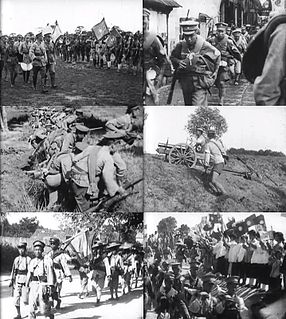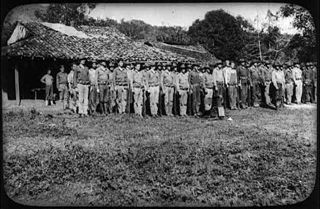 W
WThe Ararat rebellion, also known as the Ağrı rebellion, was a 1930 uprising of the Kurds of Ağrı Province, in eastern Turkey, against the Turkish government.
 W
WThe Autumn Harvest Uprising was an insurrection that took place in Hunan and Jiangxi provinces, China, on September 7, 1927, led by Mao Zedong, who established a short-lived Hunan Soviet.
 W
WThe Great Syrian Revolt or Great Druze Revolt (1925–1927) was a general uprising across Mandatory Syria and Lebanon aimed at getting rid of the French, who had been in control of the region since the end of World War I. The uprising was not centrally coordinated; rather, it was attempted by multiple factions – among them Sunni, Druze, Alawite, Christian, and Shia – with the common goal of ending French rule. The revolt was ultimately put down by French forces.
 W
WThe Guangzhou Uprising, Canton Uprising or Canton Riots of 1927 was a failed communist uprising in the city of Guangzhou (Canton) in southern China.
 W
WThe Ikhwan Revolt began in 1927, when the tribesmen of the Otaibah and Mutayr and Ajman rebelled against the authority of Ibn Saud and engaged in cross-border raids into parts of Trans-Jordan, Mandatory Iraq and the Emirate of Kuwait. The relationship between the House of Saud and the Ikhwan deteriorated into an open bloody feud in December 1928. The main instigators of the rebellion were defeated in the Battle of Sabilla, on 29 March 1929. Ikhwan tribesmen and troops loyal to Abd al-Aziz Ibn Saud clashed again in the Jabal Shammar region in August 1929, and Ikhwan tribesmen attacked the Awazim tribe on 5 October 1929. Faisal al-Dawish, the main leader of the rebellion and the Mutair tribe, fled to Kuwait in October 1929 before being detained by the British and handed over to Ibn Saud. Faisal Al-Dawish would die in Riyadh on 3 October 1931 from what appears to have been a heart condition. Government troops had finally suppressed the rebellion on 10 January 1930, when other Ikhwan rebel leaders surrendered to the British. In the aftermath, the Ikhwan leadership was slain, and the remains were eventually incorporated into regular Saudi units. Sultan bin Bajad, one of the three main Ikhwan leaders, was killed in 1931, while al-Dawish died in prison in Riyadh on 3 October 1931.
 W
WThe Battle of La Paz Centro took place on May 16, 1927 during the American occupation of Nicaragua of 1926–1933. It took place after the end of Nicaraguan civil war of 1926–1927 and prior to the Sandino Rebellion of 1927–1933.
 W
WThe Malaita massacre inflicted a large number of deaths on the island of Malaita in the Solomon Islands in late 1927. William R. Bell, the District Officer of Malaita in the British Solomon Islands Protectorate, and many of his deputies were killed by Basiana and other Kwaio warriors as part of a plan to resist the head tax imposed by the colonial authorities and what was perceived as an assault on the traditional values. A retributive raid was organised that ultimately resulted in the death of about 60 Kwaio, in addition to nearly 200 incarcerated and a systematic destruction and desecration of important Kwaio ancestral shrines and ritual objects. The event was of extreme significance for the Kwaio people, and has greatly affected their way of life.
 W
WThe Nanchang Uprising was the first major Nationalist Party of China–Communist Party of China engagement of the Chinese Civil War, begun by the Chinese Communists to counter the Shanghai massacre of 1927 by the Kuomintang.
 W
WThe Nanking Incident occurred in March 1927 during the capture of Nanjing by the National Revolutionary Army (NRA) in their Northern Expedition. Foreign warships bombarded the city to defend foreign residents against rioting and looting. Several ships were involved in the engagement, including vessels of the Royal Navy and the United States Navy. Marines and sailors were also landed for rescue operations. Both Nationalist and Communist soldiers within the NRA participated in the rioting and looting of foreign-owned property in Nanjing.
 W
WThe Northern Expedition was a military campaign launched by the National Revolutionary Army (NRA) of the Kuomintang (KMT), also known as the "Chinese Nationalist Party", against the Beiyang government and other regional warlords in 1926. The purpose of the campaign was to reunify China, which had become fragmented in the aftermath of the Revolution of 1911. The expedition was led by Generalissimo Chiang Kai-shek, and was divided into two phases. The first phase ended in a 1927 political split between two factions of the KMT: the right-leaning Nanjing faction, led by Chiang, and the left-leaning faction in Wuhan, led by Wang Jingwei. The split was partially motivated by Chiang's purging of communists within the KMT, which marked the end of the First United Front. In an effort to mend this schism, Chiang Kai-shek stepped down as the commander of the NRA in August 1927, and went into exile in Japan.
 W
WThe Battle of Ocotal occurred in July 1927, during the American occupation of Nicaragua. A large force of rebels loyal to Augusto César Sandino attacked the garrison of Ocotal, which was held by a small group of US Marines and Nicaraguan National Guards. Ultimately the rebels were defeated with heavy losses, while the Americans and their Nicaraguan allies suffered very light casualties.
 W
WThe Battle of San Fernando took place on July 25, 1927 during the American occupation of Nicaragua of 1926–1933. Shortly after the Battle of Ocotal, an expedition of seventy-eight American Marines and thirty-seven Nicaraguan Provisional Guardsmen led by Major Oliver Floyd were sent hunting for rebel leader Augusto César Sandino. One of their destinations was the town of San Fernando, where Sandino had about forty men waiting for the Marines and their Nicaraguan allies. He placed a sentry outside the village to alert his men of the Marines and Provisional Guard's arrival, but the watchman abandoned his post to be alone with an Indian girl in a nearby shack. The Marines and Nicaraguan government troops marched into San Fernando at 3:00, finding it largely deserted. While galloping across the town's "open, grassy plaza" in order to question an old man, Captain Victor F. Bleasdale and Marine Private Rafael Toro received fire from the waiting Sandinistas, with Toro being mortally wounded. Eventually, the Sandinistas were driven back, leaving eleven of their dead behind. Fighting was over by 3:45. In addition to Marine and Sandinista losses, one woman was wounded in the legs by fire from an automatic weapon.
 W
WThe Battle of Santa Clara took place on 27 July 1927, during the American occupation of Nicaragua of 1926–1933. After being ambushed by Sandinista forces at the Battle of San Fernando, Major Oliver Floyd's expedition of American Marines and Nicaraguan Provisional Guardsmen continued its advance into enemy-held territory in northern Nicaragua.
 W
WThe Shanghai massacre of April 12, 1927, known commonly in China as the April 12 Purge or April 12 Incident, was the violent suppression of Communist Party of China (CPC) organizations in Shanghai by the military forces of Generalissimo Chiang Kai-shek and conservative factions in the Kuomintang. Following the incident, conservative KMT elements carried out a full-scale purge of Communists in all areas under their control, and even more violent suppression occurred in Guangzhou and Changsha. The purge led to an open split between left and right wing factions in the KMT, with Chiang Kai-shek establishing himself as the leader of the right wing faction based in Nanjing, in opposition to the original left-wing KMT government based in Wuhan led by Wang Jingwei.
 W
WThe Battle of Telpaneca was an engagement fought during the United States occupation of Nicaragua in 1927.
 W
WThe epic of Ain Albu Gomaa, one of the military operations carried out by revolutionary groups in the city of Deir Ezzor in early June 1925 against the French forces during the Great Syrian Revolution.